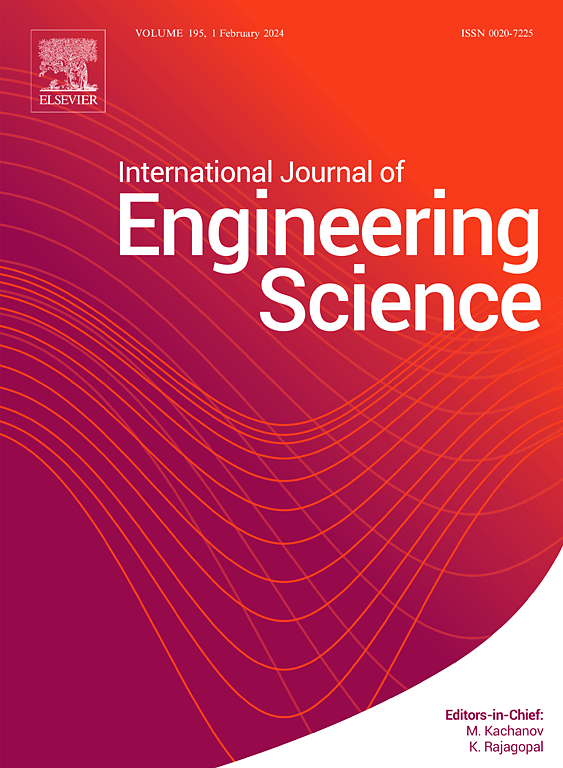Dynamic relaxation in metallic glasses: A unified view from quasi-point defects and fractional viscoelasticity
IF 5.7
1区 工程技术
Q1 ENGINEERING, MULTIDISCIPLINARY
International Journal of Engineering Science
Pub Date : 2025-10-04
DOI:10.1016/j.ijengsci.2025.104394
引用次数: 0
Abstract
Amorphous solids are ubiquitous in nature, and their non-Debye relaxation behaviors are often modeled using the stretched exponential function or the power-law form. However, these empirical approaches lack a clear physical landscape and direct ties to the underlying microstructure. Dynamic mechanical relaxation is a key metric for understanding the mechanical and physical properties of amorphous solids with viscoelastic characteristics. This study focuses on dynamic mechanical relaxation behavior of Cu50Zr43Al7 metallic glass, a typical representative of amorphous solids. We employ the simplified modified fractional-order model, combining the quasi-point defect theory and the fractional calculus, to investigate the mechanical relaxation spectrum of Cu50Zr43Al7 metallic glass in temperature domain. Our findings demonstrate the convergence between mechanical (simplified modified fractional-order model) and physical (quasi-point defect theory) viewpoints. Molecular dynamics simulations reveal that variations of parameter (or ) in the models is closely related to changes in icosahedral clusters. Additionally, calculation of local pair entropy for atoms before and after annealing, along with analysis of the “entropy-rising” atoms during annealing, show a strong correlation with the quasi-point defects.
金属玻璃的动态松弛:从准点缺陷和分数粘弹性的统一观点
非晶固体在自然界中无处不在,它们的非德拜弛豫行为通常用拉伸指数函数或幂律形式来建模。然而,这些经验方法缺乏清晰的物理景观和与底层微观结构的直接联系。动态力学松弛是理解具有粘弹性特性的非晶态固体力学和物理特性的关键指标。本文主要研究非晶固体的典型代表Cu50Zr43Al7金属玻璃的动态力学弛豫行为。采用简化的修正分数阶模型,结合准点缺陷理论和分数阶微积分,研究了Cu50Zr43Al7金属玻璃在温度域的力学弛豫谱。我们的发现证明了力学(简化修正分数阶模型)和物理(准点缺陷理论)观点之间的收敛性。分子动力学模拟表明,模型中参数χ(或α)的变化与二十面体簇的变化密切相关。此外,计算了退火前后原子的局域对熵S2,并对退火过程中原子的“熵上升”现象进行了分析,结果表明准点缺陷与局域对熵S2有很强的相关性。
本文章由计算机程序翻译,如有差异,请以英文原文为准。
求助全文
约1分钟内获得全文
求助全文
来源期刊

International Journal of Engineering Science
工程技术-工程:综合
CiteScore
11.80
自引率
16.70%
发文量
86
审稿时长
45 days
期刊介绍:
The International Journal of Engineering Science is not limited to a specific aspect of science and engineering but is instead devoted to a wide range of subfields in the engineering sciences. While it encourages a broad spectrum of contribution in the engineering sciences, its core interest lies in issues concerning material modeling and response. Articles of interdisciplinary nature are particularly welcome.
The primary goal of the new editors is to maintain high quality of publications. There will be a commitment to expediting the time taken for the publication of the papers. The articles that are sent for reviews will have names of the authors deleted with a view towards enhancing the objectivity and fairness of the review process.
Articles that are devoted to the purely mathematical aspects without a discussion of the physical implications of the results or the consideration of specific examples are discouraged. Articles concerning material science should not be limited merely to a description and recording of observations but should contain theoretical or quantitative discussion of the results.
 求助内容:
求助内容: 应助结果提醒方式:
应助结果提醒方式:


